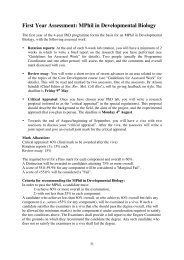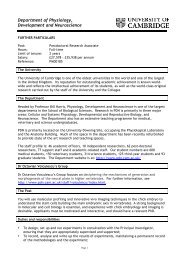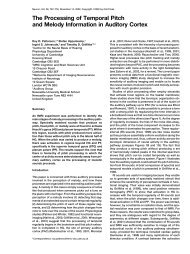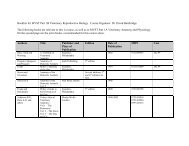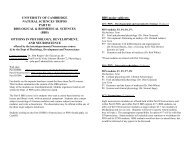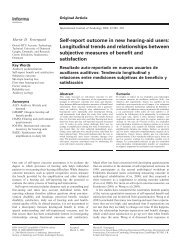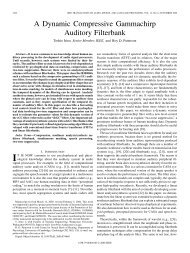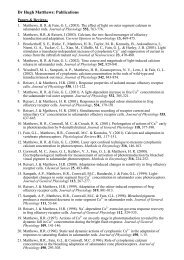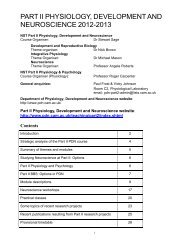FRIDAY MORNING, 20 MAY 2005 REGENCY E, 8:30 A.M. TO 12:00 ...
FRIDAY MORNING, 20 MAY 2005 REGENCY E, 8:30 A.M. TO 12:00 ...
FRIDAY MORNING, 20 MAY 2005 REGENCY E, 8:30 A.M. TO 12:00 ...
You also want an ePaper? Increase the reach of your titles
YUMPU automatically turns print PDFs into web optimized ePapers that Google loves.
2:10–2:15 Break<br />
2:15–4:15<br />
Panel Discussion<br />
<strong>FRIDAY</strong> AFTERNOON, <strong>20</strong> <strong>MAY</strong> <strong>20</strong>05<br />
<strong>REGENCY</strong> D, 1:<strong>00</strong> <strong>TO</strong> 5:<strong>00</strong> P.M.<br />
Session 5pSC<br />
Speech Communication: Speech Production and Perception II „Poster Session…<br />
Bryan W. Gick, Chair<br />
Dept. of Linguistics, Univ. of British Columbia, 1866 Main Mall E 270, Vancouver, BC V6T 1Z1, Canada<br />
Contributed Papers<br />
All posters will be on display from 1:<strong>00</strong> p.m. to 5:<strong>00</strong> p.m. To allow contributors an opportunity to see other posters, contributors of<br />
odd-numbered papers will be at their posters from 1:<strong>00</strong> p.m. to 3:<strong>00</strong> p.m. and contributors of even-numbered papers will be at their<br />
posters from 3:<strong>00</strong> p.m. to 5:<strong>00</strong> p.m.<br />
5pSC1. Perceptual development of phonotactic features in Japanese<br />
infants. Ryoko Mugitani NTT Commun. Sci. Labs., NTT Corp., 2-4<br />
Hikari-dai, Seika-cho, Soraku-gun, Kyoto, 619-0237, Japan, Laurel Fais<br />
Univ. of British Columbia, Vancouver, BC, Canada V6T 1Z4, Sachiyo<br />
Kajikawa, Shigeaki Amano NTT Corp., Seika-cho, Soraku-gun, Kyoto,<br />
619-0237, Japan, and Janet Werker Univ. of British Columbia,<br />
Vancouver, BC, Canada V6T 1Z4<br />
Acceptable phonotactics differ among languages. Japanese does not<br />
allow consonant clusters except in special contexts and this phonotactic<br />
constraint has a strong effect on adults speech perception system. When<br />
two consonants follow one another in nonsense words, adult Japanese<br />
listeners hear illusory epenthetic vowels between the consonants. The current<br />
study is aimed at investigating the influence of language-specific phonotactic<br />
rules on infants’ speech perception development. Six-, <strong>12</strong>-, and<br />
18-month-old infants were tested on their sensitivity to phonotactic<br />
changes in words using a habituation-switch paradigm. The stimuli were<br />
three nonsense words: ‘‘keet /ki:t/,’’ ‘‘keets /ki:ts/,’’ and ‘‘keetsu<br />
/ki:tsu/.’’ ‘‘Keetsu’’ perfectly follows Japanese phonotactic rules.<br />
‘‘Keets’’ is also possible in devoicing contexts in fluent speech, but the<br />
acceptability of ‘‘keets’’ for adult native Japanese speakers is much less<br />
than ‘‘keetsu.’’ ‘‘Keet’’ is phonotactically impossible as a Japanese word.<br />
The results indicate the existence of a developmental change. Twelve<br />
months and older infants detected a change from the acceptable Japanese<br />
word ‘‘keetsu’’ to the possible but less acceptable word ‘‘keets.’’ However,<br />
discrimination between ‘‘keets’’ and the non-Japanese ‘‘keet’’ is seen only<br />
in 18-month infants. Implications for infants’ speech perception with relation<br />
to language specific phonotactical regularities will be discussed.<br />
5pSC2. Temporal evidence against the production of word-internal<br />
syllable structure. Melissa A. Redford Dept. of Linguist., <strong>12</strong>90 Univ.<br />
of Oregon, Eugene, OR 97403, redford@darkwing.uoregon.edu<br />
A production study examined whether the temporal pattern that cues<br />
onset cluster syllabification in English should be attributed to syllable<br />
structure per se or to coarticulatory processes that depend on segment<br />
identity and sequencing, but not on syllable structure. Experiment 1 tested<br />
for independent effects of syllable structure on intervocalic stop-liquid<br />
consonant duration. Three speakers produced stimuli in which sequence<br />
order, boundary strength, and stress were manipulated. The results showed<br />
that stimuli with word-internal sequences were produced with similar<br />
stop-liquid duration (S:L) ratios regardless of sequence order or stress.<br />
When a word boundary split the consonants, S:L ratios were much<br />
smaller, primarily because liquids were longer. Experiment 2 was aimed at<br />
distinguishing between alternate explanations for the pattern observed in<br />
Experiment 1. Data from three Russian speakers suggested that the English<br />
pattern was due to word-internal liquid reduction rather than to<br />
boundary lengthening. The S:L ratios in Russian were not affected by<br />
sequence order or boundary strength. Further, the ratios were significantly<br />
different from the word-internal S:L ratios of English, but not from the<br />
word-peripheral ones. Overall, the results argue against a causal relationship<br />
between syllable structure and articulatory timing, and for word-sized<br />
articulatory units in English.<br />
5pSC3. Perception of coarticulated speech with contrastively<br />
enhanced spectrotemporal patterns. Travis Wade and Lori Holt Dept.<br />
Psych., Carnegie Mellon Univ., 5<strong>00</strong>0 Forbes Ave., Pittsburgh, PA 15213,<br />
twade@andrew.cmu.edu<br />
High-level contrastive mechanisms cause perception of auditory<br />
events to be influenced by spectral and temporal properties of surrounding<br />
acoustic context, and may play a role in perceptual compensation for<br />
coarticulation in human speech. However, it is unknown whether auditory<br />
contrast is incorporated optimally to compensate for different speakers,<br />
languages and situations or whether amplification of the processes involved<br />
would provide additional benefit, for example, in the perception of<br />
hypoarticulated speech, under adverse listening conditions, or in an incompletely<br />
acquired language. This study examines effects of artificial<br />
contrastive modification of spectrotemporal trajectories on the intelligibility<br />
of connected speech in noise by native and non-native listeners. Adopting<br />
methods known to improve automatic classification of speech sounds,<br />
we model contrast-providing context as an averaged estimated vocal tract<br />
function LPC-derived log area ratio coefficient vector over a Gaussianweighted<br />
temporal window. Local coefficient values are adjusted from this<br />
context based on previously observed contrastive perceptual tendencies,<br />
and the intelligibility of the resulting speech is compared with that of<br />
unmodified trajectories across listener language backgrounds. Results are<br />
discussed with respect to implementation and applicability of general auditory<br />
processes.<br />
2617 J. Acoust. Soc. Am., Vol. 117, No. 4, Pt. 2, April <strong>20</strong>05 149th Meeting: Acoustical Society of America 2617<br />
5p FRI. PM



